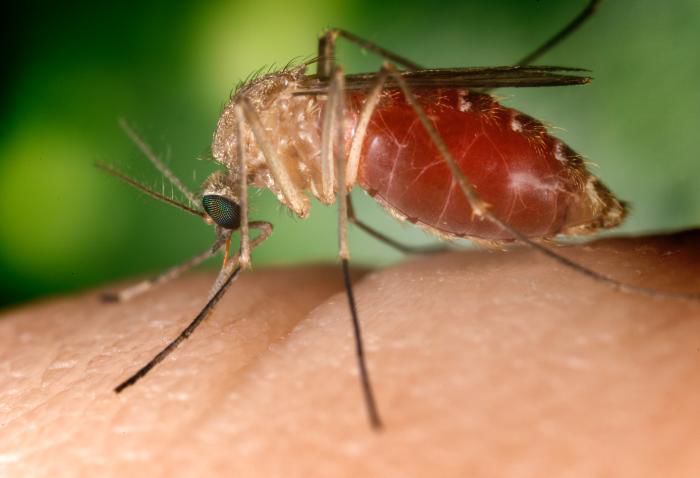Study finds high rates of West Nile Virus in western Iowa
January 16, 2020
A study done by Iowa State medical entomologists found transmission of West Nile virus most often occurs in Iowa’s western counties.
The study, published in the academic journal Scientific Reports, drew on 15 years of data collected by mosquito surveillance efforts led by the ISU Medical Entomology Laboratory. The research found the species Culex tarsalis, which is most often associated with transmission of West Nile, is more abundant in Iowa’s western-most counties.
These findings correlate with human cases of West Nile virus, which also occur at higher rates in western Iowa than in other parts of the state, said Ryan Smith, assistant professor of entomology and director of the medical entomology laboratory.
The study also examined the intensity of West Nile virus infection in humans and mosquitoes in Iowa over the last 15 years, which peaks in early September.
Smith said the study should reinforce for Iowans that West Nile remains a real concern in the state, with transmission of the disease occurring every year.
“This is the most comprehensive study of West Nile virus transmission in the state since the virus was first introduced here,” Smith said in a press release. “It’s a reminder to Iowans that this virus is here and probably isn’t going away anytime soon.”
West Nile virus is the leading cause of mosquito-borne disease in the United States, according to the Centers for Disease Control (CDC). Infected mosquitoes transmit the disease to humans through their bite, and one in five infected humans develop symptoms, such as a fever.
“West Nile virus (WNV) is most commonly spread to people by the bite of an infected mosquito,” according to the CDC. “Cases of WNV occur during mosquito season, which starts in the summer and continues through fall.”
There are no vaccines to prevent or medications to treat WNV in people, but most people infected with WNV do not feel sick.
“About 1 in 5 people who are infected develop a fever and other symptoms,” according to the CDC. “About 1 out of 150 infected people develop a serious, sometimes fatal, illness.”
The study analyzed data collected by the mosquito surveillance program led by the ISU Medical Entomology Laboratory between 2002 and 2016. The laboratory conducts yearly surveillance of mosquito populations, using a network of traps across the state. Each trap is regularly emptied and the mosquitoes inside are catalogued. Some are tested for the presence of the virus.
Smith said nuisance species, such as Aedes vexans, are the most common mosquitoes in Iowa. But the species most likely to carry the virus are Culex pipiens and Culex tarsalis. These species are most active around dusk and dawn during the summer and early fall months.
Smith said the lab’s research showed Culex tarsalis tends to feed on humans more often than other Culex species, making it a prime suspect in West Nile transmission.
The study shows counties in western Iowa, particularly those along the Missouri River, are at a higher risk of West Nile virus infections due to the increased abundance of Culex tarsalis populations in this region of the state.
The findings form a consensus with similar surveillance studies in Nebraska and South Dakota, which also implicate Culex tarsalis in the majority of West Nile virus cases. Smith said Iowa is positioned along a transition zone for North American mosquito populations, with Culex tarsalis more abundant in Nebraska, South Dakota and western Iowa and becoming less abundant in central and eastern Iowa.
“The research gives a strong indication that this particular mosquito species, Culex tarsalis, is likely most often responsible for the West Nile transmission in the state,” he said in a press release. “However, other regions of the state are still at risk of transmission from other Culex species.”
Smith recommended Iowans use insect repellent with DEET if they intend to be outside for an extended period of time during the summer months. He also recommended Iowans stay indoors at dusk and dawn, when Culex mosquitoes are most likely to feed.
DEET, chemical name, N,N-diethyl-meta-toluamide, is the active ingredient in many repellent products, according to the Environmental Protection Agency (EPA) website. It is widely used to repel biting pests such as mosquitoes and ticks.
Products containing DEET currently are available to the public in a variety of liquids, lotions, sprays and impregnated materials, like towelettes. Formulations registered for direct application to human skin contain from 5 to 99 percent DEET, according to the EPA website.
DEET is designed for direct application to people’s skin to repel insects. Rather than killing them, DEET works by making it hard for these biting bugs to smell us. After it was developed by the U.S. Army in 1946, DEET was registered for use by the general public in 1957.
Approximately 120 products containing DEET are currently registered with EPA by about 30 different companies.







